
Concept explainers
(a)
Interpretation:
The structural formula is required for Hydrogen peroxide (
Concept Introduction:
The structure formula is the representation of the position of its atoms present in molecules along with the bonds which are present in between the atoms of molecule. There are two model which can help to detemine the sturcture of molecule: Lewis Model and VSEPR Model- The valence-shell electron-pair repulsion model.
Answer to Problem 10.17P
Following is structure formula of Hydrogen peroxide (

- Oxygen can form two covalent bonds and there are two unshared pair of electron present on each oxygen atom. Here both oxygen atoms are joined forming one single bond with hydrogen and two pairs are represnted with dots which is completing octet of oxygen.
- Hydrogen atom can form one covalent bond and there is no unshared pair of electron. Both hydrogen atoms are bonded with oxygen atoms and completing their octet.
Explanation of Solution
The structure of any atom is prepared with the help of Lewis model which explains guideline for bonding of atom. It guides about the covalent bonds which are formed in various combinations of single, double and triple bonds.
For several covalent bonds in organic compound containing carbon bonded to hydrogen, nitrogen, chlorine and oxygen shows some important points to be noted for structure are as follow:
- Carbon forms four covalent bonds while hydrogen form one covalent bond and both has no unshared pair of electrons.
- Three covalent bonds are formed in nitrogen atom with only one unshared pair of electron left behind.
- Oxygen can form two covalent bonds and have further more two unshared pair of electron.
- Iodine, chlorine, bromine and fluorine like halogens can form only one covalent bond like hydrogen but they have three unshared pair of electrons.
Following is structure formula of Hydrogen peroxide (
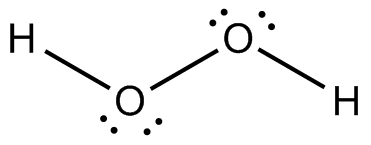
- Oxygen can form two covalent bonds and there are two unshared pair of electron present on each oxygen atom. Here both oxygen atoms are joined forming one single bond with hydrogen and two pairs are represnted with dots which is completing octet of oxygen.
- Hydrogen atom can form one covalent bond and there is no unshared pair of electron. Both hydrogen atoms are bonded with oxygen atoms and completing their octet.
(b)
Interpretation:
The structural formula is required for Hydrazine (
Concept Introduction:
The structure formula is the representation of the position of its atoms present in molecules along with the bonds which are present in between the atoms of molecule. There are two model which can help to detemine the sturcture of molecule: Lewis Model and VSEPR Model- The valence-shell electron-pair repulsion model.
Answer to Problem 10.17P
Following is structural formula for Hydrazine (
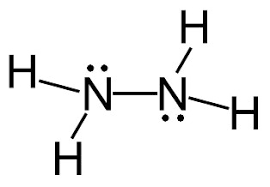
- In hydrazine, both nitrogen atoms are bonded together with single bond and have one unshared pair of electron represented as two dots on each nitrogen atom. Both nitrogen atoms has also formed single bonds with two hydrogen atoms each and completing their octet.
- All hydrogen atoms are bonded with nitrogen atoms and formed single bonds.
Explanation of Solution
The structure of any atom is prepared with the help of Lewis model which explains guideline for bonding of atom. It guides about the covalent bonds which are formed in various combinations of single, double and triple bonds.
For several covalent bonds in organic compound containing carbon bonded to hydrogen, nitrogen, chlorine and oxygen shows some important points to be noted for structure are as follow:
- Carbon forms four covalent bonds while hydrogen form one covalent bond and both has no unshared pair of electrons.
- Three covalent bonds are formed in nitrogen atom with only one unshared pair of electron left behind.
- Oxygen can form two covalent bonds and have further more two unshared pair of electron.
- Iodine, chlorine, bromine and fluorine like halogens can form only one covalent bond like hydrogen but they have three unshared pair of electrons.
Following is structural formula for Hydrazine (
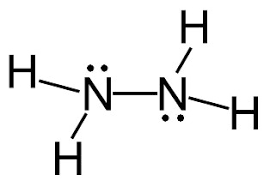
- In hydrazine, both nitrogen atoms are bonded together with single bond and have one unshared pair of electron represented as two dots on each nitrogen atom. Both nitrogen atoms has also formed single bonds with two hydrogen atoms each and completing their octet.
- All hydrogen atoms are bonded with nitrogen atoms and formed single bonds.
(c)
Interpretation:
The structural formula is required for Methanol (
Concept Introduction:
The structure formula is the representation of the position of its atoms present in molecules along with the bonds which are present in between the atoms of molecule. There are two model which can help to detemine the sturcture of molecule: Lewis Model and VSEPR Model- The valence-shell electron-pair repulsion model.
Answer to Problem 10.17P
Following is structural formula for Methanol (
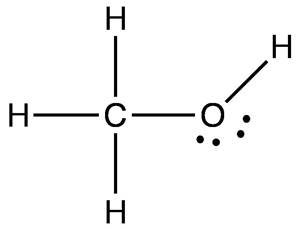
- Methanol has one oxygen atom which has two single bonds with hydrogen and carbon and two unshared pair of electrons is represented with dots over oxygen symbol.
- Three hydrogen atoms are bonded with carbon atoms and formed single bonds whereas rest hydrogen is bonded with oxygen and forming single bond.
- Carbon atom is linked with three hydrogen atoms and one oxygen atom forming total four single bonds and there is no unshared pair of electron with it.
Explanation of Solution
The structure of any atom is prepared with the help of Lewis model which explains guideline for bonding of atom. It guides about the covalent bonds which are formed in various combinations of single, double and triple bonds.
For several covalent bonds in organic compound containing carbon bonded to hydrogen, nitrogen, chlorine and oxygen shows some important points to be noted for structure are as follow:
- Carbon forms four covalent bonds while hydrogen form one covalent bond and both has no unshared pair of electrons.
- Three covalent bonds are formed in nitrogen atom with only one unshared pair of electron left behind.
- Oxygen can form two covalent bonds and have further more two unshared pair of electron.
- Iodine, chlorine, bromine and fluorine like halogens can form only one covalent bond like hydrogen but they have three unshared pair of electrons.
Following is structural formula for Methanol (
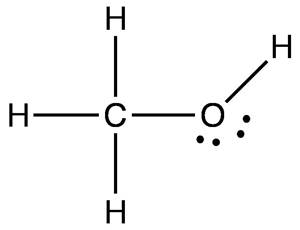
- Methanol has one oxygen atom which has two single bonds with hydrogen and carbon and two unshared pair of electrons is represented with dots over oxygen symbol.
- Three hydrogen atoms are bonded with carbon atoms and formed single bonds whereas rest hydrogen is bonded with oxygen and forming single bond.
- Carbon atom is linked with three hydrogen atoms and one oxygen atom forming total four single bonds and there is no unshared pair of electron with it.
(d)
Interpretation:
The structural formula is required for Methanethiol (
Concept Introduction:
The structure formula is the representation of the position of its atoms present in molecules along with the bonds which are present in between the atoms of molecule. There are two model which can help to detemine the sturcture of molecule: Lewis Model and VSEPR Model- The valence-shell electron-pair repulsion model.
Answer to Problem 10.17P
Following is structural formula for Methanethiol (

- In Methanethiol, carbon atom is linked with one sulphur and three hydrogen atoms forming four single bonds and completing its octet.
- One hydrogen atom has formed single bond with sulphur whereas three hydrogen atoms has formed single bonds with carbon and completed their octet.
- Sulphur has two unshared pair of electrons and two single bonds with hydrogen and carbon.
Explanation of Solution
The structure of any atom is prepared with the help of Lewis model which explains guideline for bonding of atom. It guides about the covalent bonds which are formed in various combinations of single, double and triple bonds.
For several covalent bonds in organic compound containing carbon bonded to hydrogen, nitrogen, chlorine and oxygen shows some important points to be noted for structure are as follow:
- Carbon forms four covalent bonds while hydrogen form one covalent bond and both has no unshared pair of electrons
- Three covalent bonds are formed in nitrogen atom with only one unshared pair of electron left behind.
- Oxygen can form two covalent bonds and have further more two unshared pair of electron.
Following is structural formula for Methanethiol (
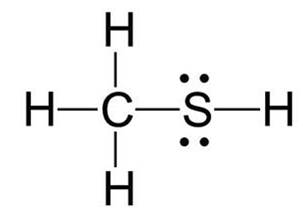
- In Methanethiol, carbon atom is linked with one sulphur and three hydrogen atoms forming four single bonds and completing its octet.
- One hydrogen atom has formed single bond with sulphur whereas three hydrogen atoms has formed single bonds with carbon and completed their octet.
- Sulphur has two unshared pair of electrons and two single bonds with hydrogen and carbon.
(e)
Interpretation:
The structural formula is required for Methylamine (
Concept Introduction:
The structure formula is the representation of the position of its atoms present in molecules along with the bonds which are present in between the atoms of molecule. There are two model which can help to detemine the sturcture of molecule: Lewis Model and VSEPR Model- The valence-shell electron-pair repulsion model.
Answer to Problem 10.17P
Following is structural formula for Methylamine (
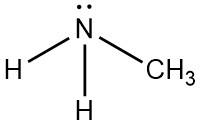
- Nitrogen atom in methylamine is linked with carbon and two hydrogen atoms through single bonds and one unshared pair of electrons is seen on symbol of atom.
- Carbon atom has one single bond with nitrogen atom and three single bonds with hydrogen atoms which results into completion of octet of carbon with no unshared pair of electron.
- Total five hydrogen atoms are present in methylamine from which two hydrogen atoms have single bonds with nitrogen atoms and three hydrogen atoms have single bond with carbon atoms and completing their octet.
Explanation of Solution
The structure of any atom is prepared with the help of Lewis model which explains guideline for bonding of atom. It guides about the covalent bonds which are formed in various combinations of single, double and triple bonds.
For several covalent bonds in organic compound containing carbon bonded to hydrogen, nitrogen, chlorine and oxygen shows some important points to be noted for structure are as follow:
- Carbon forms four covalent bonds while hydrogen form one covalent bond and both has no unshared pair of electrons.
- Three covalent bonds are formed in nitrogen atom with only one unshared pair of electron left behind.
- Oxygen can form two covalent bonds and have further more two unshared pair of electron.
- Iodine, chlorine, bromine and fluorine like halogens can form only one covalent bond like hydrogen but they have three unshared pair of electrons.
Following is structural formula for Methylamine (

- Nitrogen atom in methylamine is linked with carbon and two hydrogen atoms through single bonds and one unshared pair of electrons is seen on symbol of atom.
- Carbon atom has one single bond with nitrogen atom and three single bonds with hydrogen atoms which results into completion of octet of carbon with no unshared pair of electron.
- Total five hydrogen atoms are present in methylamine from which two hydrogen atoms have single bonds with nitrogen atoms and three hydrogen atoms have single bond with carbon atoms and completing their octet.
(f)
Interpretation:
The structural formula is required for Chloromethane (
Concept Introduction:
The structure formula is the representation of the position of its atoms present in molecules along with the bonds which are present in between the atoms of molecule. There are two model which can help to detemine the sturcture of molecule: Lewis Model and VSEPR Model- The valence-shell electron-pair repulsion model.
Answer to Problem 10.17P
Following is structural formula for Chloromethane (

- Chloromethane has halogen atom as chlorine which is linked with carbon atom and forming single bond and has three unshared pair of electrons.
- Carbon completes its octet by forming three single bonds with three hydrogen atoms and one single bond with chlorine.
- All three hydrogen forms single-single bonds with carbon and fills their octet.
Explanation of Solution
The structure of any atom is prepared with the help of Lewis model which explains guideline for bonding of atom. It guides about the covalent bonds which are formed in various combinations of single, double and triple bonds.
For several covalent bonds in organic compound containing carbon bonded to hydrogen, nitrogen, chlorine and oxygen shows some important points to be noted for structure are as follow:
- Carbon forms four covalent bonds while hydrogen form one covalent bond and both has no unshared pair of electrons.
- Three covalent bonds are formed in nitrogen atom with only one unshared pair of electron left behind.
- Oxygen can form two covalent bonds and have further more two unshared pair of electron.
- Iodine, chlorine, bromine and fluorine like halogens can form only one covalent bond like hydrogen but they have three unshared pair of electrons.
Following is structural formula for Chloromethane (

- Chloromethane has halogen atom as chlorine which is linked with carbon atom and forming single bond and has three unshared pair of electrons.
- Carbon completes its octet by forming three single bonds with three hydrogen atoms and one single bond with chlorine.
- All three hydrogen forms single-single bonds with carbon and fills their octet.
Want to see more full solutions like this?
Chapter 10 Solutions
Introduction to General, Organic and Biochemistry
- C5H8 has two elements of unsaturation (right?), which may indicate the presence of either double bonds or triple bonds or rings. Show all the possible structuresarrow_forwardThe curved arrow notation introduced in Section 1.6B is a powerfulmethod used by organic chemists to show the movement of electronsnot only in resonance structures, but also in chemical reactions.Because each curved arrow shows the movement of two electrons,following the curved arrows illustrates what bonds are broken andformed in a reaction. Consider the following three-step process. (a) Addcurved arrows in Step [1] to show the movement of electrons. (b) Use thecurved arrows drawn in Step [2] to identify the structure of X. X isconverted in Step [3] to phenol and HCl.arrow_forwardWrite a condensed structural formula for an acid with the formula C4H8O2arrow_forward
- whwn naming a compound do ignore the di,tertri and the iso and juat look at the alphebets of the names, like dimethyl and isopropyl;arrow_forward2. Write bond-line structural formulas for (a.) two primary alcohols, (b.) a secondary alcohol, and (c.) atertiary alcohol—all having the molecular formula C4H10O.arrow_forwardwhat is the complete lewis structure of acetic anhydride such that all atoms have zero formal charge?arrow_forward
- The carbon–carbon bond length in C2H2 is 1.20 Å, that inC2H4 is 1.34 Å, and that in C2H6 is 1.53 Å. Near which ofthese values would you predict the bond length of C2 tolie? Is the experimentally observed value, 1.31 Å, consistent with your prediction?arrow_forwardWrite structural formula for the following compound Q) C2H4Br2: d 2.5 (d, 3H) and 5.9 (q, 1H)arrow_forwardGive the name and structure of the compounds represented by A, B, C, D, E, F, G, and Harrow_forward
- What structural features help us identify a compound as(a) an alkane, (b) a cycloalkane, (c) an alkene, (d) an alkyne,(e) a saturated hydrocarbon, (f) an aromatic hydrocarbon?arrow_forwardTo satisfy the octet rule, fullerenes must have doublebonds. How many? Give a simple rule for one way ofplacing them in the structure shown in Figure 7.17a.arrow_forwardConsider the compound C₂H₃N. Which one of the structures in Figure 4 is the best representation of this compound based on your current knowledge? * A B C D All these structures are good representations of the compound.arrow_forward
